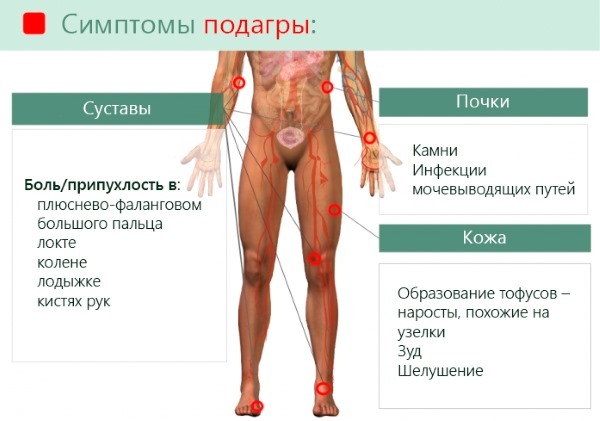Knee-joint in the human body it is the largest, it can withstand heavy loads. Against the background of numerous factors, its defeat occurs, which leads to the development of various diseases. An orthopedic surgeon, arthrologist or rheumatologist will help to establish a diagnosis. It is necessary to go to the hospital at the first signs in order to be examined and start treatment.
Record content:
-
1 Knee joint diseases: causes, symptoms, classification
- 1.1 Synovitis
- 1.2 Arthritis
- 1.3 Periarthritis
- 1.4 Acute and chronic gonarthritis
- 1.5 Tendinitis
- 1.6 Deforming osteoarthritis
- 1.7 Koenig's disease
- 1.8 Osgood-Schlatter disease
- 1.9 Baker's cyst
- 1.10 Meniscopathy
- 1.11 Chondropathy
- 1.12 The consequences of trauma
- 1.13 Rare knee joint pathologies
-
2 Clinical guidelines
- 2.1 Diagnostics
- 2.2 Conservative treatment
- 2.3 Surgical intervention
- 3 Prognosis for various pathologies
- 4 Video about knee joint diseases
Knee joint diseases: causes, symptoms, classification
As a result of constant load on the lower limbs, due to mechanical stress, damage or internal changes, pathological processes develop.
They provoke inflammation and changes in the structures of the knee joint, against the background of which numerous diseases develop. Pathological processes are accompanied by characteristic signs and require timely medical attention. Otherwise, a person will face serious consequences, including disability.
Synovitis
The disease is characterized by the accumulation of abnormal joint fluid. The synovium becomes inflamed.
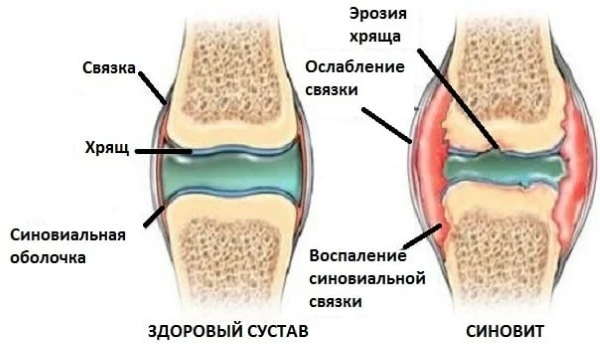
The pathological condition occurs for certain reasons and is accompanied by characteristic clinical symptoms:
| Causes | Signs | Classification |
|
|
|
The disease in a mild form is treated with medications, physiotherapy procedures. In difficult situations, surgery is performed to remove excess articular fluid.
Arthritis
The inflammatory process in the area of the knee joint is provoked by numerous factors, characteristic symptoms appear.
| Causes | Signs | Classification |
|
|
|
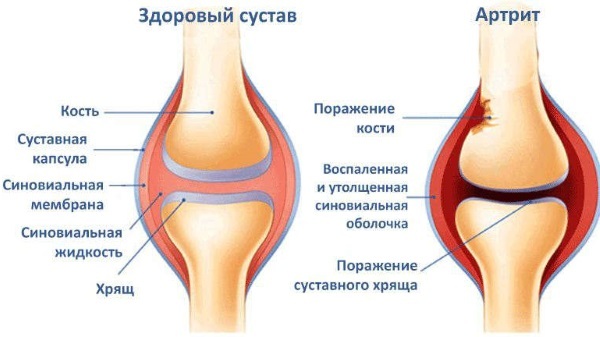
It is important to establish the defeat at an early stage, since advanced forms of pathology are more difficult to treat.
Periarthritis
The disease is characterized by inflammation of the tissues that are located near the knee joint (ligaments, muscles, tendons).
| Causes | Signs | Classification |
|
|
|
The treatment is carried out in a comprehensive manner with the use of medicines, folk remedies and physiotherapy procedures.
Acute and chronic gonarthritis
Gonarthritis is an inflammatory disease of the knee joint. Pathology negatively affects the condition of the cartilage. The connective tissue stiffens, grows, which causes painful sensations and other symptoms.
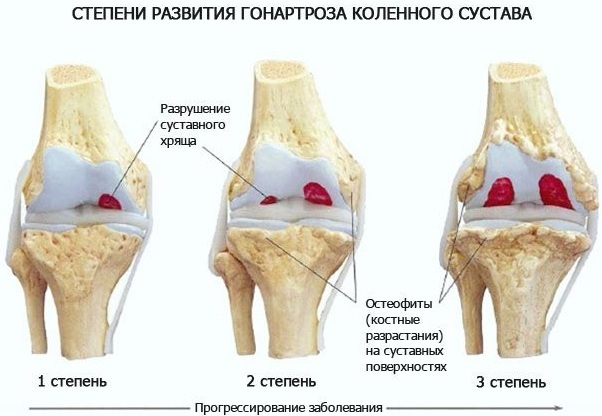
| Causes | Signs | Classification |
|
|
|
Timely therapy will prevent serious complications, including deterioration of joint mobility, up to disability.
Tendinitis
A commonly diagnosed disease characterized by damage to the tendon of the knee joint. As the pathological processes progress, severe inflammation develops.
| Causes | Signs | Classification |
|
|
|
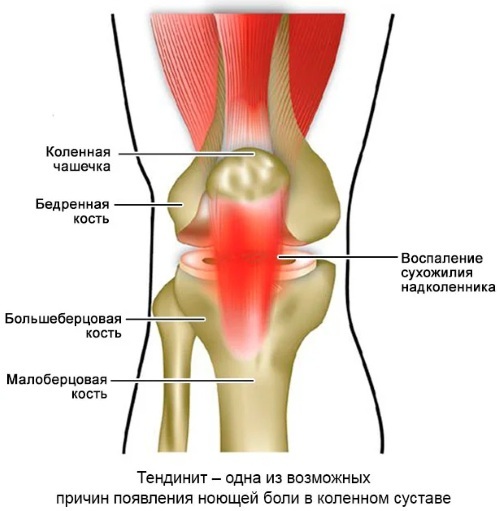
Pathology proceeds in stages, an orthopedist will help diagnose it, prescribing a comprehensive examination for the patient.
Deforming osteoarthritis
Deforming osteoarthritis is a chronic disease of the knee joint. The inflammatory process affects the joint. Cartilage ages quickly, degenerative changes develop.
| Causes | Signs | Classification |
|
|
|
The disease develops slowly, progressive processes first affect one knee joint. After a while, the inflammation passes to the second knee.
Koenig's disease
A rare pathology, which is also called osteochondritis dissecans. The disease is characterized by the free movement of a certain part of the cartilage in the synovial bursa.
| Causes | Signs | Classification |
|
|
|
Koenig's disease is dangerous in the later stages of development, when, as a result of the lack of timely therapy, the risk of deforming arthrosis increases. In this situation, the joint completely loses its mobility.
Osgood-Schlatter disease
Osgood-Schlatter disease is characterized by the formation of a specific lump below the patella. Pathology is more often diagnosed in children or adolescents during adolescence.
| Causes | Signs |
|
|
The disease in most cases proceeds without complications. With age, the pathology disappears, some external changes remain that do not affect the functioning of the knee.
Baker's cyst
The disease is characterized by the formation of a bump in the popliteal fossa. The tumor is filled with synovial fluid. As its size increases, a person develops characteristic clinical symptoms.

| Causes | Signs | Classification |
|
|
|
As the pathological processes progress, the patient is disturbed by unbearable pain, the color of the skin in the affected area of the lower limb changes, and trophic ulcers form.
Meniscopathy
Diseases of the knee joint in a group that affect the menisci and contribute to the development of degenerative processes are called meniscopathy. The knee is impaired. To make an accurate diagnosis, you will need a consultation with a traumatologist.
| Causes | Signs | Classification |
|
|
|
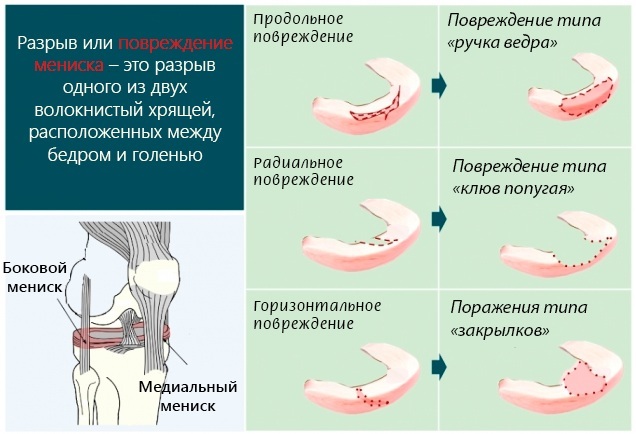
The malformation of the meniscus and its separation from the capsule of the knee joint can also provoke the disease.
Chondropathy
Chondropathy is characterized by an irreversible pathological process that affects the patella.
| Causes | Signs | Classification |
|
|
|
At risk are the elderly, young children, as well as athletes and obese patients.
The consequences of trauma
It is important to diagnose diseases of the knee joint or its damage in a timely manner in order to start treatment and prevent possible complications.
| Name | Description |
| Rupture of blood vessels | The pathological condition provokes hemorrhage into the cavity of the knee joint, against the background of which its functioning is impaired. |
| Ligament rupture | The consequence of a severe injury to the knee, as a result of which it is difficult for a person to lift or bend a leg.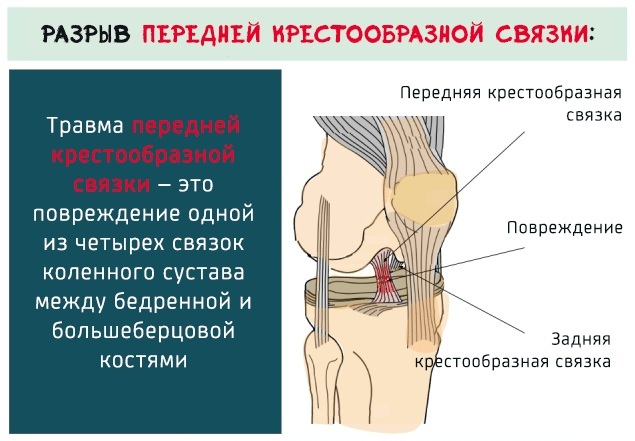
|
| Lameness | Complication of a knee injury that has not been fully healed. |
| Disability | In the absence of timely therapy, irreversible deformation of the joint occurs. |
The most severe consequences of knee joint injuries is the complete loss of its mobility (contracture, ankylosis). The same goes for the fracture and displacement of the menisci, rupture of the ligaments. Amortization of movements is also impaired, muscle tissue dies off, destructive processes develop in the area of cartilage.
Rare knee joint pathologies
The knee joint in the human body is an important component of the musculoskeletal system. As a result of the heavy load, it is affected by numerous inflammatory and degenerative processes. In the absence of timely therapy, there is a high likelihood of rare but serious pathologies.
| Name | Description |
| Goff's disease | The pathological disease is characterized by the degeneration of adipose tissue in the area of the knee joint. A person is worried about severe pain, soft tissues swell. |
| Chronic meniscitis | Pathology occurs as a result of prolonged damage to the knee joint. The inflammatory process affects the menisci. Long-term traumatic effects provoke microcracks and erosion. |
| Patellar syndrome | The disease is difficult to differentiate, since it is accompanied by numerous symptoms. There is instability of the patella, damage to the meniscus. Tendinitis develops. |
| Isolated gonarthritis | The pathology is rare and develops after a severe injury to the knee joint. Sometimes it is a concomitant disease of other degenerative-inflammatory processes (synovitis, hemarthrosis, meniscus rupture, deforming osteoarthritis). |
Rare diseases of the knee joint also include chronic bursitis of the patella, tendinosis, and pigmented villous synovitis. Only a qualified doctor can carry out differential diagnostics, with deep knowledge and experience to establish an accurate diagnosis.
Clinical guidelines
Diseases of the knee joint require patients to undergo a complete comprehensive diagnosis. Patients go to a specialist (orthopedist, arthrologist, rheumatologist, surgeon) who conducts an examination.
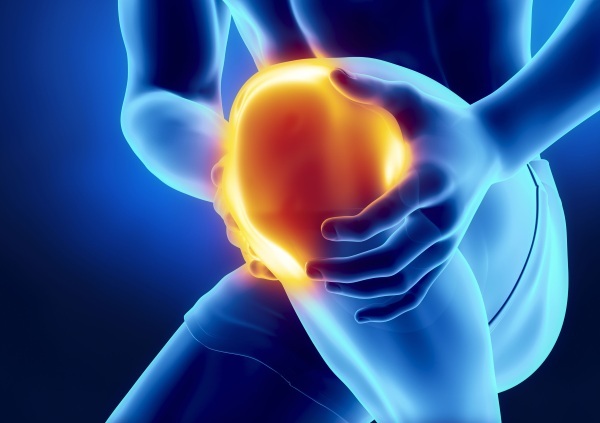
After a preliminary diagnosis is made, additional tests are prescribed. Taking into account the results obtained, the doctor makes a diagnosis and selects special medications. Many diseases of the knee joint are treated with folk remedies or with the help of physiotherapy procedures, but in a comprehensive manner.
Diagnostics
The doctor will help to establish an accurate diagnosis by prescribing a comprehensive examination for the patient. First of all, the patient is examined. The specialist detects hyperemia and swelling of soft tissues, soreness. Based on the results of a preliminary examination, the doctor establishes a diagnosis, but to confirm it, he prescribes additional tests.
The following methods help diagnose knee joint disease:
| Name | Description |
| X-ray | The specialist examines the structures of the knee joint, identifies inflammatory foci, fractures, and chronic pathological processes. X-rays are prescribed for arthritis and osteoarthritis. |
| Computed tomography (CT) | The most informative diagnostic methods that allow you to visually see abnormalities in the knee joint area. The specialist detects any pathological changes in the bones, ligaments, menisci or joint capsule. |
| Magnetic resonance imaging (MRI) | |
| Puncture | The procedure is indicated for an increase in the volume of synovial fluid. The material taken is examined under laboratory conditions. The specialist determines the degree of development and the origin of the inflammatory process. |
| Arthroscopy | Intra-articular structures are examined. Often during the operation, the doctor not only examines, but also treats the knee joint. The procedure is minimally invasive, therefore, soft tissue damage is minimal. |
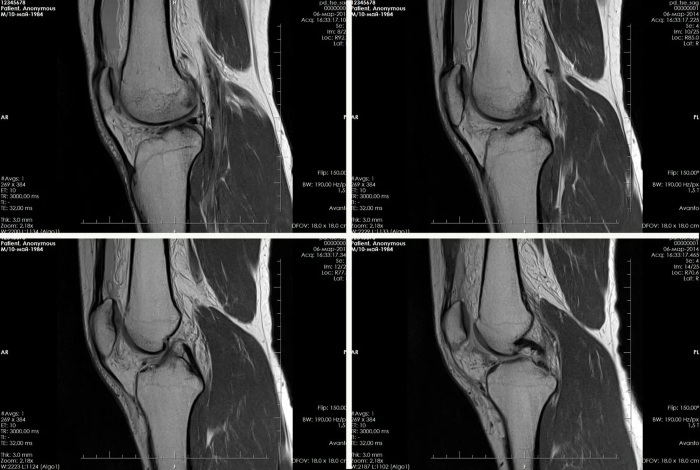
The results obtained after a comprehensive diagnosis will help the doctor choose the most effective treatment for the patient, taking into account also the individual characteristics of his body. It is important to strictly adhere to the appointments in order to prevent possible complications.
Conservative treatment
An orthopedist, arthrologist, rheumatologist or surgeon deals with the diagnosis and treatment of pathologies of the knee joint. The specialist prescribes medications for patients, taking into account the results of complex diagnostics, the condition of a person and the individual characteristics of his body.
| Group of drugs | Name | Application |
| Anti-inflammatory drugs | Nimesil, Nurofen | The drugs reduce pain and inflammation. The adult dosage is 100 mg 2 times a day. It is recommended to take the medicine after meals, dissolve in water (250 ml). |
| Chondroprotectors | Chondroitin, Glucosamine | Medicines help restore cartilage tissue. The drug is taken orally with plenty of water. Adults are prescribed 750 mg 2 times a day. The course of treatment lasts 3 weeks. Further, the dosage is reduced to 500 mg 2 times a day. The total duration of therapy is 6 months. |
| Pain medications | Pentalgin, Tempalgin | The drugs eliminate severe pain syndrome. The medicine is recommended to be taken orally 1 tablet 1-3 times a day. The course of treatment is carried out for 3-5 days. |

If there is a secondary infection, the patient is prescribed special antibacterial agents. Additionally, topical medications (gels, ointments) are used, which relieve swelling and pain, and reduce the inflammatory process.
In emergency situations, with severe painful sensations, the patient is prescribed intra-articular injections. They eliminate swelling and swelling of soft tissues. Injections are given once a month.
Surgical intervention
Diseases of the knee joint sometimes require surgery if the patient does not feel better after conservative therapy. Pathological processes progress, the human condition worsens.
Surgical intervention, taking into account the cause of the disease and the main diagnosis, is carried out by the following methods:
| Name | Description |
| Arthroscopy | A minimally invasive operation, during which the doctor uses a special device - an arthroscope. The procedure is necessary to eliminate pain in the area of the knee joint, restore its mobility, the joint itself and muscle performance. |
| Arthrotomy | Surgical intervention involves a complete opening of the joint to remove a foreign body, purulent contents, or affected tissue. |
| Arthrodesis | An operation during which the doctor immobilizes the joint to reduce the progression of pathological processes. |
| Prosthetics | The procedure involves the complete replacement of the knee joint or certain elements of it with artificial parts. A lasting result after the intervention is guaranteed for a long time.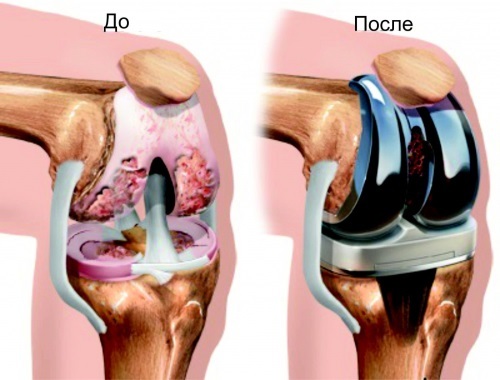
|
The operation helps to restore the mobility of the knee joint, remove changes in the cartilage tissue, the formed growths, and spalling fragments. After surgery, the patient is prescribed special drugs in order to recover sooner and prevent possible complications.
Prognosis for various pathologies
Predictions for diseases of the knee joint depend on the state of the person, the degree of development of inflammatory and degenerative processes. Treatment of pathology at an early stage of development allows you to fully recover and continue to live fully.
The advanced stages of the disease require long and complex therapy, in some cases even surgery. After surgical treatment, the patient needs time to recover. We must not forget about repeated relapses, their probability is high if the patient does not follow the doctor's recommendations.
Timely determination of the pathologies of the knee joint will prevent serious complications, including disability and the chronic course of pathological processes. The first clinical signs and abnormalities should not be ignored. Doctors recommend going to the hospital right away for medical help.
Video about knee joint diseases
Causes and treatment of knee pain:



